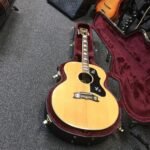Parlor vs dreadnought acoustics, is it worth making a comparison between these vastly different guitars?
Can the parlor hope to compete against the dreadnought?
Is there a chance that the parlor will overtake the dreadnought’s popularity as it used to?
When it comes to parlor vs dreadnought acoustics, the key differences between the two are so significant that it makes it hard to pick just one, you’re better off getting a dreadnought first because it is an all-rounder and then a parlor for its convenience and portability.
With that said, let’s still try to see the key differences between the two so you can make a more informed decision.
After all, these instruments have the ability to change how you play and ultimately how you will sound. Read on to find out more:
1. Size Difference
Where the jumbo went to the larger end of the scale, the parlor goes in the opposite direction.
If we were to say the dreadnought was the standard size, then the parlor acoustic guitar would definitely be defined as smaller than the standard size.
Despite the parlor acoustic guitar being the smallest in the common acoustic guitar body shapes, it is not to be confused with travel guitars or mini guitars.
Those are entirely separate categories of their own.
You could say those are modern iterations of the acoustic guitar to address modern guitarist needs.
The parlor, on the other hand, was designed to be a fully playing acoustic guitar for its time.
When placed beside a dreadnought acoustic guitar, it is quite easy to see the major differences between the two.
The size alone is a dead giveaway.
| Measure | Dreadnought | Parlor |
| Total Body Length | 20 inches | 18.25 inches |
| Lower Bout Measurement | 15.6 inches | 13.5 |
| Upper Bout Measurement | 11.5 inches | 13 inches |
| Body Depth | 4.6 inches | 3.75 inches |
2. Distinct Shape Differences Between The Parlor And The Dreadnought
The parlor is the smallest representative of the common acoustic guitar body shapes.
It gives off a rather “streamlined” shape with its narrower upper and lower bouts akin to a peanut shape if viewed from afar.
This is what instantly separates the look of the parlor from the dreadnought.
The dreadnought will always look bigger than a parlor due to how its body is constructed.
Its boxy shape makes it hard to confuse the dreadnought with a parlor if you already know what the common body shapes are.
3. Significant Volume Disparity Between The Two Instruments
Due to its small size, the parlor can’t hope to produce as much volume as a dreadnought.
But it can cut through the mix if you pluck or pick individual notes just right.
The parlor is perfect for playing lead lines with if you have a dreadnought playing rhythm under the melody.
Needless to say, the dreadnought has the perfect volume setting amongst all other acoustic guitar types which is why it is set as the standard of all the other instruments.
In conclusion, the parlor was never meant to be loud.
It was designed to be a personal musical instrument that could comfortably entertain a small crowd as long as the acoustics of the room were correct.
It is easy to drown the sound produced by a parlor out with loud voices in the background.
The lack of a strong volume does not mean the parlor can’t be played onstage. Modern guitar pickup technology has made volume issues a thing of the past.
Slap one on a parlor and you can play this instrument onstage and fully amplified.
4. Punchy Tone Vs General All-Rounder Tone
For their small size, parlors produce a punchy sound.
This is due to the sound not having too much space within the sound chamber to reverberate in. instead, it gets pushed out almost immediately which gives it that slight “oomph” in the sound.
Despite that punchiness, the parlor can still deliver delicate performances.
Train your fingers to provide just enough pressure for fretting and plucking, strumming, or picking and you have a near-perfect instrument for playing music with.
5. Different Strokes For Different Folks
Parlor guitars are best for players who find larger-bodied guitars unwieldy or hard to play with.
Parlor guitars are also perfect for keeping and playing around the house.
Place it in a highly accessible area and all you have to do is run over to it and grab it, find a comfortable spot and just start playing when the spirit hits you.
So if you’re looking for a highly portable, playable instrument, then the parlor is the perfect instrument for you.
6. Practical Usage
Parlor guitars, because of their small size, can be taken and played anywhere. This makes parlor guitars excellent travel guitars.
As long as you have a hard case ready for your parlor, a trip anywhere with your guitar is going to be a stress-free affair.
Dreadnoughts, on the other hand, as a general all-rounder, can be played for almost all types of situations.
This can negate the need for getting a parlor if you already have a dreadnought.
But then again, the tone difference and excellent portability the parlor offers are very enticing for some guitarists looking for a unique instrument they can take along with them, anywhere.
7. Price
Parlor guitars aren’t as readily available as dreadnoughts and may be treated as high-value guitars by those wishing to capitalize on the lack of supply.
But in areas where you will find parlor guitars, they are relatively inexpensive and can compete with the dreadnought’s price range anytime.
Which One Should You Get?
Once again, the dreadnought is the perfect guitar if you want an all-rounder that is readily available in the market and relatively cheap to purchase.
You can never go wrong with the dreadnought’s ability to produce sweet tones.
The parlor acoustic guitar is for those who just want a handy guitar at home that they can easily pick up, play with and not worry about bothering the neighbors.
Parlors are also perfect for entertaining small crowds at home or around a campfire.
Struck hard enough and with a calculated amount of finesse, the parlor can sound just as great as a dreadnought without too much punchiness in the tone.
For best results, use the fleshy pad of your thumb and fingers for downstrokes and upstrokes respectively.
If you’re looking for a travel guitar, the parlor may not be the best option.
It is still not constructed in a way to receive as much abuse as those specifically designed to take along with on trips.
In conclusion, the parlor is a great personal guitar that can inspire you musically but is an instrument best kept at home.

Hello there, my name is Ramiro and I’ve been playing guitar for almost 20 years. I’m obsessed with everything gear-related and I thought it might be worth sharing it. From guitars, pedals, amps, and synths to studio gear and production tips, I hope you find what I post here useful, and I’ll try my best to keep it entertaining also.





